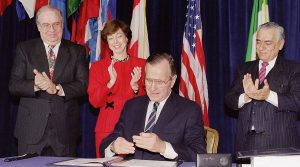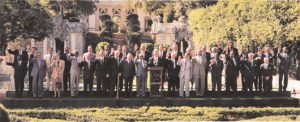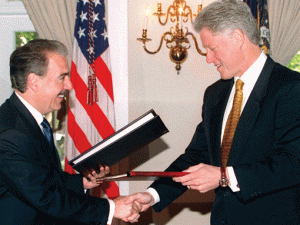“Speech on North American Free Trade Agreement, and Republican Party Hispanics, George H. W. Bush Administration Civil Rights Files”, (1993)

US President George Bush caps his pen after signing the North American Free Trade Agreement at the Organization of American States headquarters, 17 December 1992, in Washington D.C.. Looking on are Mexican Ambassador Gustavo Petricioli (L), US Trade Representative Carla Hills and Canadian Ambassador Derek Burney (R). (Photo credit should read RENAUD GIROUX/AFP/Getty Images)
During George H. W. Bush presidency, the governments of the US, Mexico and Canada started to negotiate an economic agreement that would eventually help the three countries commercial relations. This speech served to convince the Republican party Hispanics to support him on the negotiated agreement that according to the president, will put the US into the world spotlight as an economic leader and at the same time help Mexico with their economic issues. On January 1, 1994, NAFTA (North American Free Trade Agreement) went into effect with specific rules and agreements that protected things like labor, transparency and even the environment. NAFTA provided mutual cooperation between the three countries, solidified relationships and encouraged economic and environmental growth in the region. This compromise shows the US intentions of improving relationships and promoting economic expansion in the region. The US knew that this agreement will further help countries like Mexico to develop its economy while also helping themselves develop as a dominant economy in the region and in the world.
First Summit of the Americas: Declaration of Principles (January 1, 1994).

First Summit of the Americas:
Miami, Florida, USA, December 9 – 11, 1994
After NAFTA was signed in 1994, on the same year, the head of states of thirty-four American nations gathered in Miami to create a “Free Trade Area of the Americas”. Most of the countries in Latin America supported a region-wide free trade agreement but countries like Venezuela opposed the pact. Venezuela’s opposition to pact in the summit was the first warning to the US about Venezuela’s future plans for the region. Similar to NAFTA, the Summit of the Americas was trying to pursue prosperity and growth in the entire region through open markets and mutual cooperation. Among with the integration of free trade and economic growth, the summit also discussed preserving democracy and eliminating discrimination in the region. The states of the Summit mutually agreed to improve the quality of life of marginalized groups and respect their rights because that is what democracy is based on. The agreement also mentioned the importance of maintain stable and transparent governments when fighting common issues such as corruption and organized crime. Once again, this agreement is another example of how the US is trying to positively influence Latin American nations with the ultimate goal of improving relationships after years of intervention. This also shows the influence the US has over the states of the region when it comes to democracy.
The Drug War: Plan Colombia, (1999)

A special relationship: The U.S.and Colombia have collaborated on security through three administrations, beginning with that of Colombian President Andrés Pastrana (left) and U.S. President Bill Clinton. (Stephen Jaffe/AFP/Getty)
Since the 1970’s, the US “war on drugs” had significantly affected US Foreign Policy towards Latin America. At the end of the 1990s, Colombia became the target for the US to establish anti-drug policies. The Colombian president of the time, Andres Pastrana, delivered a televised address about the US-Colombia plan to eradicate illegal trafficking on September 17, 1999. The plan is known as “Plan Colombia”. In the plan, Colombia recognizes its flaws within the government and pledges to regain the confidence of its people by fighting illegal trafficking and widespread violence. Both countries came up with elements to confront the transnational issue like economic development to counterbalance narco-trafficking, enhance military strategy to protect the rule of law, promoting human development to increase education and an international cooperation that will block the trade flow of illicit drugs. At the end of the plan, both countries committed their efforts to fight against illegal drug production and further secure order and stability. They both also agreed that it’s for the region’s best interest to tackle this issue before it reaches to unbearable levels.
